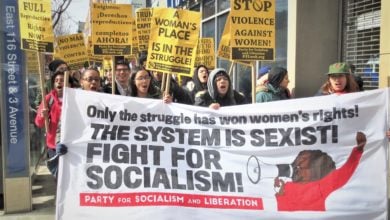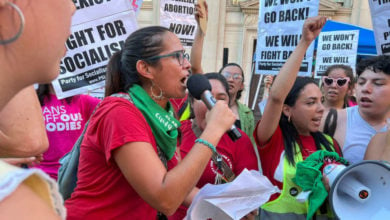June 24 marks the 2nd anniversary of Dobbs v. Jackson Women’s Health Organization, the Supreme Court case that overturned Roe v. Wade, dramatically rolling back a foundational right for women to legally control our reproductive capacities. Abortion as a federal right was abolished and left up to the states. Where does the struggle for reproductive justice stand at this moment?
Just a few days ago, the Supreme Court rejected a legal effort challenging the legality of mifepristone, a key drug used in medication abortions. Since 2022, ballot initiatives on the legality of abortion have shown the overwhelming popular support for access to this important medical procedure. Meanwhile, countless women have been forced to travel across state lines for abortion care, or are forced to remain pregnant against their will. The Democrat Party continues to use the issue of abortion in an attempt to drum up support for Pres. Joe Biden’s re-election, while the anti-abortion movement has even more firmly latched onto former Pres. Donald Trump who alternates between taking credit for Dobbs, supporting states rights on abortion and hinting that he would sign a 15 or 16 week federal ban on abortion. However, women, abortion providers, allies and others have stepped up grassroots efforts for abortion access and to politically protect the right to abortion care.
Abortion pill ruling
The SCOTUS decision on June 13 allowed mifepristone to continue to be available for use in medication abortions, but the ruling was based on technical grounds. The court determined that the right-wing doctors who brought the case had no standing.
“The decision is good that the doctors don’t have standing,” said Dr. Rebecca Gomperts, director of Aid Access, an abortion pill supplier working with U.S. providers. “The problem is, the decision should have said that nobody has standing in this case – that only the women have standing.” (AP)
The decision leaves the door open for future attempts to ban the drug: Justice Brett Kavanaugh in the opinion states. “Citizens and doctors who object to what the law allows others to do may always take their concerns to the Executive and Legislative Branches and seek greater regulatory or legislative restrictions on certain activities,” he wrote. (AP)
While not a resounding victory for the legality of mifepristone, a medication that has been deemed safe and legal for many years, it is clear the court, one packed with anti-abortion conservatives, chose to refrain from banning the medicine due to the strength of the grassroots pro-abortion movement as seen by the many popular votes on state abortion initiatives. In the first year after Dobbs, pro-abortion voters prevailed in every state where the issue was on the ballot: Kansas, Montana, Vermont, Michigan, Kentucky, California and Ohio. Activists in nine other states are working to pass abortion protection initiatives in 2024. There is no doubt that support for abortion is strong even in states that are dominated by the GOP — and abortion rights supporters are able to mobilize politically at the grassroots level.
Impact of Dobbs
Destiny Lopez, co-CEO of the Guttmacher Institute, testified before the Senate Committee on Health, Education, Labor, and Pensions: “Access to abortion care is severely restricted in many parts of the country. Fourteen states are now enforcing total abortion bans with very limited exceptions, and many more have other new restrictions in place. The total number of brick-and-mortar clinics providing abortion care in the US declined by more than 40 between 2020 and early 2024.
“Banning abortion does not stop the need for abortion access. Which is why many people seeking abortions post-Dobbs must overcome huge financial and logistical barriers to get care, especially those in states with total or early gestational bans. The number of Americans traveling out of state for abortions doubled from 81,000 in 2020 to more than 170,000 in 2023. States that border states with total abortion bans saw the sharpest increases in out-of-state patients.” (Guttmacher Institute)
A 2024 study estimates that 65,000 pregnancies caused by rape were carried to term as a result of state bans with no exception for rape (Kentucky, Louisiana, Missouri, Oklahoma, S Dakota, Tennessee, Texas and West Virginia.)
Women carrying non-viable fetuses and those in the process of miscarrying have been forced to travel out of state to receive necessary care. In Texas, a group of these women fought back, suing the state. On May 31, the Texas State Supreme Court ruled against the women and upheld the near total ban, making it nearly impossible for a woman in Texas to get an abortion even in the face of life-threatening complications.
Roe and Dobbs
Dobbs was the final outcome of a slow motion trainwreck. The anti-abortion movement implemented a legal strategy to get a case to the Supreme Court that could overturn Roe, the landmark 1973 decision that was understood to legalize abortion until fetal viability, on the basis of privacy rights between a doctor and patient. The Roe decision came down, not out of the blue, but in a context of a powerful social movement for women’s rights which itself had origins in the movements for Black liberation and against the Vietnam War. As such, it was seen as not simply a legal doctrine but a response to changing social norms driven by the struggle for women’s liberation.
After 1973, abortion rights immediately faced attack. Despite the lukewarm defense in action of abortion from the Democrats, every presidential election cycle for decades has featured impassioned pleas for pro-choice voters to elect a Democrat who would presumably appoint Supreme Court justices more amenable to reproductive rights.
At no point during the nearly 50 years following Roe did the Democrats move to pass federal legislation enshrining abortion rights. Instead, abortion was cynically used to rally voters and to fundraise for candidates without any meaningful action taken.
There is of course much more to reproductive justice than abortion access. Due to the dire state of capitalist healthcare overall in the U.S., effective contraception is not consistently available, while on the other hand many people carrying wanted pregnancies are not getting proper prenatal care. Maternal mortality, especially among Black women and other women of color, is at a crisis level, as is infant mortality. Because they are not profitable, labor and delivery units in hospitals are being closed, leaving large regions without a place for babies to be born. Meanwhile, OB-GYN doctors are fleeing states with abortion bans, leaving a shortage of doctors to provide reproductive health care to women.
Resistance grows
For the past two years the struggle has been fought mostly on a state level, because each state has had different laws. But the most recent manifestation of this growing movement is on a global level — witness the global women’s strike planned for June 24, the anniversary of Dobbs. The action is demanding equal rights, reproductive freedom and an end to gender-based violence. This action has been picked up by the Women’s March and will take place in cities across the U.S.
While some leaders of the June 24 actions will no doubt promote the idea of voting for Biden to protect reproductive rights, women will come out because they have had enough. It’s hard to imagine that an electorate horrified by a genocide in Gaza that has killed thousands of Palestinian women and children and destroyed every hospital will hold their noses to vote for Joe Biden on the basis of abortion alone since he has failed to do much in the face of the biggest crisis for abortion access of our era.
Access to abortion and contraception is a basic prerequisite for women’s full participation in capitalist society. But women and others oppressed on the basis of gender need much more than what capitalism can provide to achieve our full potential as human beings.
It’s necessary to maintain revolutionary optimism in the face of so much suffering caused by the abortion bans passed following Dobbs. We won abortion rights with Roe not because of the graciousness of some unelected judges but because an audacious, independent, radical movement for women’s equality in every aspect of social and economic life had created a seismic change. Working-class women and other oppressed people are at the forefront of every labor, anti-racist and anti-imperialist movement today. We must continue to build a working-class women’s movement independent of the capitalist establishment to defend our rights and fight for a new system under which we can achieve our full potential as human beings.






